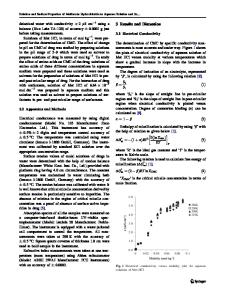The surface reactivity of hollandite in aqueous solution
- PDF / 896,472 Bytes
- 9 Pages / 576 x 792 pts Page_size
- 40 Downloads / 280 Views
Hollandite, [BaxCsj,][(Ti, Al) 2x+ yTi 8 _ 2 x+y]Oi 6 , has been subjected to aqueous chemical attack at 75 and 150 °C. The resultant surface alterations have been monitored by solution analysis, SEM/TEM investigations, and surface analysis. The evolution of the solid/solution system can be described by the following mechanisms: There is a near-instantaneous release of Cs and Ba from reactive surface sites, followed by relatively rapid dissolution of the first few monolayers. The release of Al drives the pH to low values as a result of Al-OH hydroxylation and precipitation of AIO(OH) and/or A1(OH)3 species. The rate of dissolution is reduced by an order of magnitude or more by the formation of a thin and continuous Al(Ti)-rich surface layer. The layer remains stable and protective even under extreme hydrothermal conditions. This description has implications for the use of hollandite as a ceramic phase for disposal of high level nuclear wastes.
I. INTRODUCTION Hollandite was first identified and described in 1950 by Bystrom and Bystrom.1 Its structure and crystal chemistry have been the subjects of investigations by Kesson and White.2 A more recent description can be found in Fielding and White.3 The essential structural features are shown in Fig. 1, which emphasizes the TiOg octahedral stacking sequence and the characteristic tunnels. The tunnels are of particular significance to the application of hollandite as a ceramic for disposal of high level nuclear wastes (HLW), since it has been shown that Cs can readily be accommodated in tunnel sites.2-3 The chemical durability in aqueous solution at temperatures up to 200 °C is a relevant property in the context of disposal of HLW,4"6 although there are many other criteria on which HLW solid waste forms need to be judged.7'8 The durability of the hollandite titanate ceramic has been the subject of several previous investigations.9"11 These have tended to show that its integrity in aqueous solution is intermediate in comparison with the other two major titanate phases in the Synroc HLW titanate assemblage, perovskite being less durable and zirconolite being considerably more durable. (We use Synroc as the generic term for a family of multiphase titanate ceramics, most of which have hollandite, perovskite, and zirconolite as the major phases.) A series of studies have identified the attack on the TiC>6 octahedra as being the primary mechanism for network dissolution in the case of perovskite.12'13 One should expect a similar mechanism to be operative for hollandite. If this is the case, then the question needs to be asked, and answered, as to why hollandite is more durable a)Present
address: Division of Wool Technology, CSIRO, Geelong, Victoria 3216, Australia.
3174 http://journals.cambridge.org
J. Mater. Res., Vol. 9, No. 12, Dec 1994 Downloaded: 25 Mar 2015
than perovskite. There is, therefore, a dual rationale for studying the effects of aqueous exposure on hollandite: firstly, an attempt to explain why two apparently similar titanates respond differently to ident
Data Loading...











